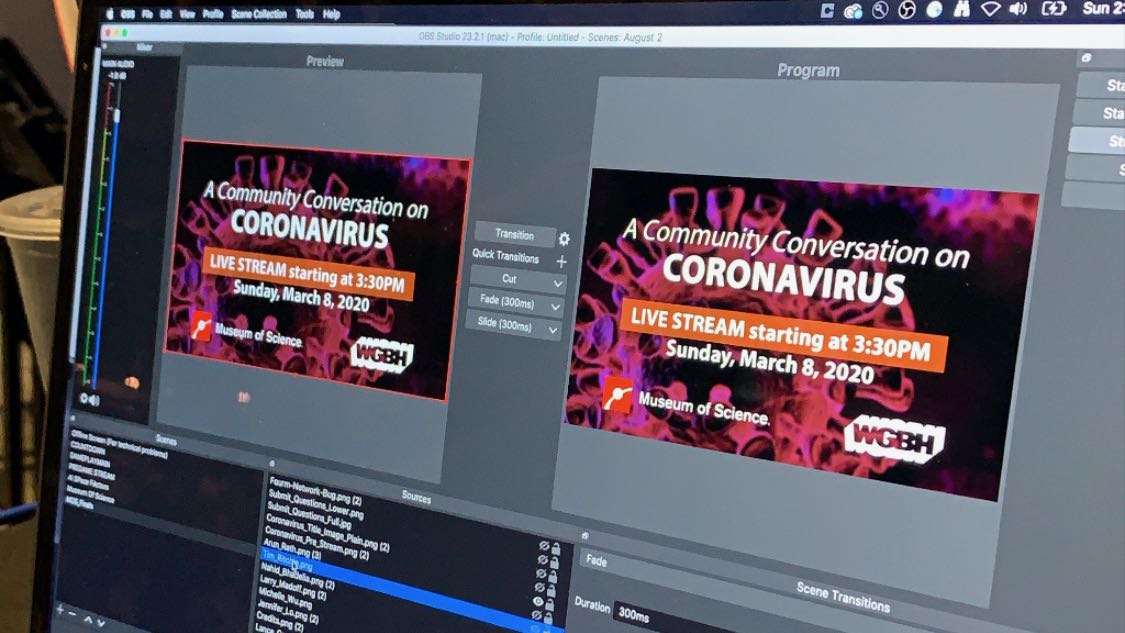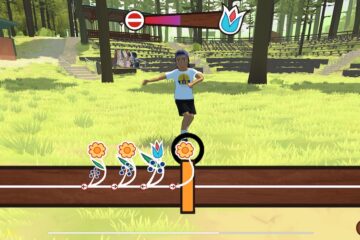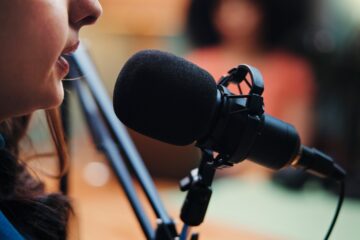How to prepare for COVID-19 as a social media manager

Tory Starr / WGBH
WGBH’s Forum Network livestreamed a community conversation on coronavirus Sunday from Boston’s Museum of Science. The stream was made available via Facebook, YouTube and Twitch for those uncomfortable with attending in person.
When it comes to public health crises, social media is at the front lines of so many things: emergency communications, official announcements, grassroots reports and, of course, rampant misinformation from both unwitting and bad actors.
As social media professionals in public media, it is our responsibility to take a step back and evaluate how our work can best contribute to public safety, health and well-being. Some tips:
- Come up with a social media plan, in the case that you or your staff face disruption at work. Better yet, come up with two plans: one in the case of remote work, and one in the case that you or your colleagues who manage social media become ill. Solidify your communications and workflow ahead of time and distribute the plan widely so that everyone is on the same page. For example, you may want to come up with a “tree” for social media management where others can step in easily.
- Social listening is more important now than ever before. If you have a social listening service such as Sprinklr, Sprout, CrowdTangle, Brandwatch, or Synthesio, set up keyword terms for mentions of COVID-19 or coronavirus in connection with your station, town and community. (If you don’t have a social listening tool, take advantage of native search tools on Facebook, Twitter, Reddit, NextDoor, etc). Take the time to hear what others are saying and share this knowledge with your station’s leadership. This type of social listening can be helpful in guiding your station’s response, identifying critical community needs or identifying important stories for your newsroom to cover. (Don’t know where to begin? Explore all articles tagged Social Listening in the WGBH Social Media Portal.)
- Double down on moderation. If you haven’t already, post your Community Guidelines as a Facebook note and link to your policy from your Twitter and Instagram bios. WGBH has seen an uptick in speculation, rumors and outright misinformation in comments recently — be clear in your actions that this type of content is not welcome on your own Pages. Hide, delete and warn users if necessary, or point them to resources that the platforms themselves have created to combat this type of activity.
- Review your posts and scheduled posts to make sure they are appropriate in light of the spread of COVID-19. Sometimes it’s the little things (such as a word that has taken on new meaning recently, or a post that makes light of something health-related) that blow up on social media. There is a fine line between being funny and using humor that offends. Give all your social posts a second look with that in mind and consider enlisting a colleague as your “gut check.”
- Refrain from any kind of blatant marketing that takes advantage of COVID-19 or anything related to the pandemic. Companies have come under heavy scrutiny with ads or social media posts in bad taste, especially the ones promoting something that seems irrelevant to the time.
- Consider livestreaming public announcements or events that members of your community might be fearful of attending. WGBH has a system in place that allows events to be easily livestreamed to our website, Facebook, YouTube, Twitter and Twitch; consider setting up a similar system at your station.
- We are facing the reality that many Americans will be spending more time at home than usual. In light of that, gather your team for a brainstorm: What can your station provide that is unique and valuable? Is it social livestreaming of important events? Curating lists of binge-able series on Passport? Fact checking or reporting on misinformation on your city or town’s subreddit? Resurfacing archival materials that show today’s situation in historical context? Facilitating Twitter chats, Reddit AMAs or livestreams with health professionals? Don’t be afraid to reallocate your time from what you had planned to do.
More resources
- First Draft News has a guide on how to investigate health misinformation using Twitter’s API and is facilitating a webinar on Newsgathering and Monitoring on Social Media March 20 at 11:30 a.m. Eastern time. Learn more from their Coronavirus: Resources for Reporters landing page.
- If you are a CrowdTangle user, they have set up COVID-19 live displays for both global and U.S. coverage and ran a webinar earlier this week with resources and tips for using CrowdTangle to monitor COVID-19 information on social.
- This post by Twitter outlines some tips for brand communication and advises on what social media users want in times of crisis: accurate and reliable information, customer service and support, distraction and levity, community and positivity.
This column was adapted from The WGBH Social Media Portal newsletter, a weekly update on social media news, trends and best practices. You can subscribe to the newsletter here.





